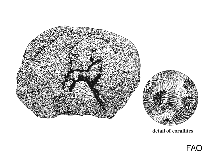Pseudodiploria clivosa (Ellis & Solander, 1786)
Knobby brain coral
Upload your photos
Google image | No image available for this species;
drawing shows typical species in Faviidae.
Google image | No image available for this species;
drawing shows typical species in Faviidae.
Classification / Names Common names | Synonyms | CoL | ITIS | WoRMS
Anthozoa | Scleractinia | Faviidae
Environment: milieu / climate zone / depth range / distribution range Ecology
Reef-associated; depth range 0 - 41 m (Ref. 83917). Tropical; 33°N - 8°N, 92°W - 58°W (Ref. 848)
Distribution Countries | FAO areas | Ecosystems | Occurrences | Introductions
Western Atlantic: Caribbean Sea to Bermuda.
Length at first maturity / Size / Weight / Age
Maturity: Lm ? range ? - ? cm
Short description Morphology
Colonies are massive (especially in shallow waters) or encrusting. The surface is usually irregular. Columellae are well-developed although interlinked. Ambulacral grooves, if present, fine. Greys and browns in color, usually with walls and valleys of contrasting colors
Zooxanthellate (Ref. 116012).
Life cycle and mating behavior Maturity | Reproduction | Spawning | Eggs | Fecundity | Larvae
Members of the class Anthozoa are either gonochoric or hermaphroditic. Mature gametes are shed into the coelenteron and spawned through the mouth. Life cycle: The zygote develops into a planktonic planula larva. Metamorphosis begins with early morphogenesis of tentacles, septa and pharynx before larval settlement on the aboral end.
Main reference
References | Coordinator | Collaborators
Collin, R., M.C. Díaz, J. Norenburg, R.M. Rocha, J.A. Sánchez, M. Schulze, A. Schwartz and A. Valdés. 2005. (Ref. 415)
IUCN Red List Status (Ref. 130435)
Near Threatened (NT) (A2bce); Date assessed: 01 June 2021
CITES status (Ref. 108899)
Appendix II: International trade monitored
CMS (Ref. 116361)
Not Evaluated
Threat to humans
Human uses
| FishSource |
Tools
More information
Internet sources
BHL | BOLD Systems | CISTI | DiscoverLife | FAO(Publication : search) | Fishipedia | GenBank (genome, nucleotide) | GloBI | Gomexsi | Google Books | Google Scholar | Google | PubMed | Hexacorallians of the World | Tree of Life | Wikipedia (Go, Search) | Zoological Record
Estimates based on models
Preferred temperature
(Ref. 115969): 25.4 - 28, mean 27.4 (based on 120 cells).
Price category
(Ref. 80766):
Unknown.



